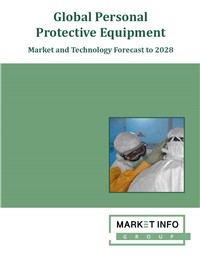Global Personal Protective Equipment Market Report analyzes the size, share, trends, technologies, opportunities for growth, competitive landscape, and forecast of the Global PPE market up to 2028. This study also includes details on restraints, improvements, business sector goals, shortcomings and advances. With growing number of construction and manufacturing projects, the likelihood of workplace hazards is expected to increase significantly. Although tremendous progress has been made in the improvement over the past few years, approximately 317 million non-fatal & 321000 fatal workplace accidents occur every year worldwide. This has prompted companies to raise awareness of health risks and adhere to workplace health and safety standards. This is expected over the forecast period to fuel demand for personal protective equipment.
The strategy used to select controls is called the "Hierarchy of Controls" which prioritizes the control types that are most effective in eliminating or reducing the risk of hazard exposure. The PPE strategy is the last efficient way to monitor or avoid exposure to a hazard after all the controls and measures are applied based on the “Hierarchy of Controls”. The PPE offers a barrier to shield the worker from possible exposure to hazards, however, the risk of exposure to the hazard with PPE depends on how he picks, wears, or maintain PPE. In certain cases, PPE is required by regulations or internal protocols and can provide additional control to help shield the worker.
The total Global Market for Personal Protective Equipment is estimated at around USD 58 Billion in 2020 and the market is expected to grow to USD 87 Billion by 2028. The Global Personal Protective Equipment market is expected to grow at a CAGR of around 5%. North America Market is expected to account for around one-fourth of the market, is driven by increased safety awareness and regulations mandating the use of protective equipment in different industries.
Scope
The study period of the report “Global Personal Protective Equipment Market” is from 2018-2028, and the forecast period of the report is from 2020-2028.
The report is aimed at:
- The Key drivers, restraints and challenges which are expected to shape the Global Personal Protective Equipment Market are covered in detailed in the report.
- The key technologies which could have an impact on the Personal Protective Equipment Market have been covered in detail.
- The top 15 countries have been analyzed in detail with respect to their current size of economy, sector wise scenario and government expenditure (2015-2018), preparedness on the epidemics such as COVID-19, COVID-19 impact on PPE market country wise.
- The Porter’s Five Forces and the PEST of the Global Personal Protective Equipment Market have been covered in the report.
- The high growth markets have been identified in the Opportunity Analysis Chapter.
- The market has been forecasted from 2020- 2028 considering all the factors, which are expected to impact the market.
- The Scenario Analysis Chapter covers the key scenarios and its impacts on the forecast chapter.
Segmentation covered in this report
The market is segmented based on End User, Region, Type, and Operation:
By End User
- Manufacturing
- Construction
- Oil and Gas
- Healthcare
- Transportation
- Firefighting
- Food
- Others
Region Wise Segmentation:
- North America
- Europe
- APAC
- Middle East
- LATAM
- ROW
By Type
- Hands and Arm Protection
- Protective Clothing
- Foot and Leg Protection
- Respiratory Protection
- Eye and Face Protection
- Head Protection
- Others
Country Level Analysis
- USA
- France
- UK
- Germany
- Italy
- Australia
- Canada
- Switzerland
- Austria
- Japan
- Indonesia
- South Korea
- Mexico
- Netherlands
- Spain
Reasons to buy
- The new players in the Personal Protective Equipment Market can use this report to understand the key market trends that are expected to shape this market in the next few years.
- The Market Analysis Chapter cover the Key Drivers, Restraints and Challenges of the Personal Protective Equipment Report. The PEST and the Porter’s five forces are covered in detailed in this report.
- The key technologies that could impact the Personal Protective Equipment have been covered in detail, an example is the growing interest in the Smart Wearables and Sensors to accelerate the safety of the workers in workplaces.
- The report can be used by sales and marketing team to formulate their medium- and long-term strategies and to reconfirm their short-term plans.
- The forecast chapter would help the sales team to formulate their medium-term sales plan.
- The report would be help to the sales and the marketing team to understand the key segments across the top ten countries which have been analyzed in the report.
- The Opportunity Analysis chapter identifies the key hot spots within the Global Personal Protective Equipment Market.
- The company profiles include financials, latest news, contracts and SWOT for around 10 companies.
Who is this report for?
- Small Manufacturers: The report would be help the Commercial PPE manufacturers to understand the high growth opportunities.
- Financial Institutions: The financial institutions like the financial brokers and the banking institutes can use this report to evaluate their funding or investment strategies.
- End Use Industries: The End Use Industries such as Healthcare, Manufacturing, Construction, Transportation, Food Industries could use this report to understand the types of PPE needed in the respective field of the top 15 countries. This would give them an overall perspective of potential markets.
- Decision Makers: The future investment and technology focus decisions could be formulated based on the inputs of this report.
- Other Organizations: Various other NGO and Non- Governmental organizations involved with the research of PPE related subject can use this report to support their research.




